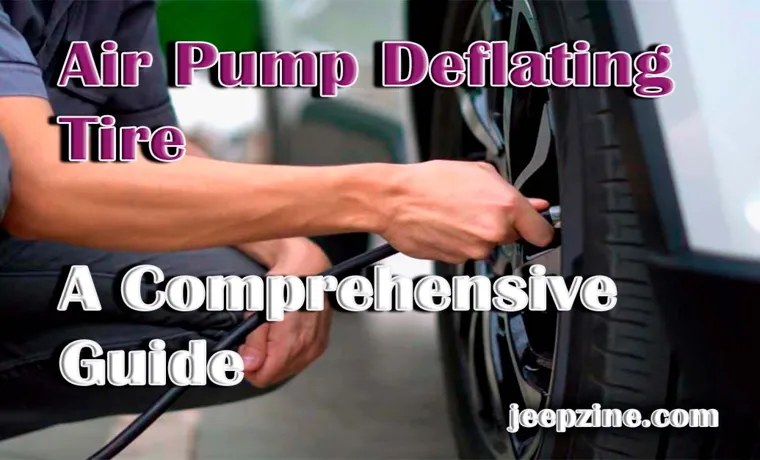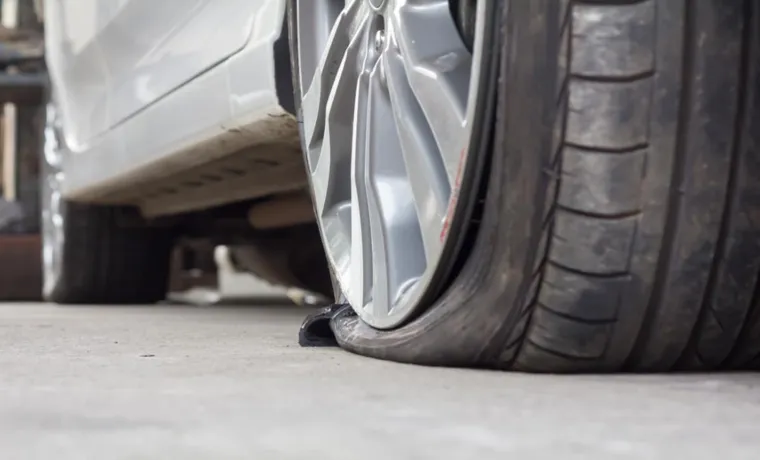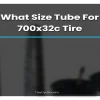Have you ever woken up in the morning to find that one of your tires is a little flat? It’s frustrating, but have you ever stopped to wonder why it’s happening? A deflating tire is not only inconvenient, but it’s also dangerous. It can cause accidents, or even lead to a tire blowout at high speeds. The root cause of a deflating tire can vary from something small like a nail puncture, to something more serious like a damaged valve stem.
The good news is that there are steps you can take to pinpoint the issue and get it fixed quickly. In this blog, we will cover everything you need to know about why your tire is deflating and how to handle the situation like a pro.
Possible Causes
If you’ve ever noticed that your tire deflates when you add air, it can be frustrating and confusing. There are several possible causes for this issue. One potential culprit is a puncture or leak in the tire, which can cause air to escape as soon as it’s added.
Another possibility is a damaged valve stem, which can prevent air from staying in the tire and causing it to deflate after filling. Additionally, it’s possible that the valve core or valve cartridge is damaged, which can cause air to leak out of the tire. It’s also worth noting that overinflating a tire can cause it to burst and deflate, so make sure to check the recommended pressure levels before adding air.
Overall, if you’re experiencing this issue, it’s important to get your tire checked by a professional to determine the root cause and avoid further problems.
Leaking Valve Stem
A leaking valve stem can be caused by a variety of factors. One common cause is a damaged valve core. The valve core can be damaged by over-tightening the valve cap or by debris and dirt that can get inside the valve stem.
Another possible cause is a damaged valve stem seal. The valve stem seal can become worn or damaged over time, which can allow air to escape from the tire. Inadequate valve stem lubrication is another potential cause of a leaking valve stem.
When the valve stem is not lubricated, it can become stiff and brittle, which can lead to air leaks. Finally, a cracked valve stem can also cause air leaks. If the valve stem is cracked or damaged in any way, then it will need to be replaced in order to prevent air leaks and ensure safe driving.
So, it is important to inspect your valve stems regularly and replace any damaged parts as soon as possible to maintain proper tire pressure and good vehicle performance.

Punctured or Damaged Tire
If you have ever experienced a punctured or damaged tire, you know how frustrating and inconvenient it can be. There are several possible causes for a punctured tire, including sharp objects on the road like nails or glass, driving on a damaged or old tire, or hitting a curb or pothole. In some cases, the tire might also be punctured intentionally, such as vandalism or theft attempts.
It’s important to remember that tires are one of the most critical safety features on your vehicle, and a damaged or punctured tire can compromise your vehicle’s performance and potentially lead to a dangerous situation on the road. Regular maintenance and visual inspections of your tires can help mitigate the risk of a puncture or damage, but if you do experience a flat tire, it’s important to pull over to a safe location and address the issue immediately.
Cracked Wheel or Rim
If you’ve ever experienced a cracked wheel or rim on your vehicle, you know how frustrating and inconvenient it can be. There are several possible causes for a cracked wheel or rim, including hitting potholes or debris in the road, improper installation, and harsh driving conditions. Potholes and debris can cause damage to the wheel or rim, weakening it over time and eventually leading to a crack.
Improper installation, such as over-tightening lug nuts or not properly centering the wheel, can also lead to a cracked wheel. Harsh driving conditions, such as frequently driving on uneven or rough terrain, can also weaken the wheel and lead to cracking. To prevent a cracked wheel or rim, it’s important to drive cautiously and avoid hitting potholes or debris in the road.
It’s also crucial to have your wheels properly installed by a professional and to avoid driving in harsh conditions whenever possible. Taking these precautions can help prolong the life of your wheels and prevent inconvenient and costly repairs.
Loose or Faulty Valve Core
A loose or faulty valve core is a common problem that can occur in your car’s tires. Several possible causes can lead to this issue, including over-tightening the valve cap or damage to the valve core itself. If the valve core is loose, air can escape from the tire, causing it to go flat.
Alternatively, if the core is faulty, it may not allow air into the tire, causing it to slowly deflate over time. No matter the cause, it’s important to address this issue as soon as possible. A simple fix can involve tightening the valve cap or replacing the valve core.
Failing to fix the problem could lead to a severe blowout while driving, putting yourself and others at risk. To avoid potential issues, make sure to check your tire pressure regularly and address any valve core issues promptly.
What to Do
If you’re experiencing tire deflation despite putting air in it, it’s likely that there’s a leak somewhere in the tire. This can be caused by various factors, such as a puncture or a faulty valve stem. To determine the cause, you’ll need to thoroughly inspect the tire for any visible signs of damage, such as cuts or scrapes.
If there’s no visible damage, try spraying a solution of soapy water over the tire while it’s inflated. If you notice bubbles forming, then you’ve found the source of the leak. Once you’ve located the leak, you can use either a tire repair kit or take it to a mechanic for a professional repair.
In some cases, the tire may need to be replaced entirely, so be sure to check the tire’s age as well. Remember to always properly inflate your tires to the recommended PSI level and regularly check for any signs of damage to ensure a safe and smooth ride.
Inspect the Tire and Valve Stem
When inspecting your tires and valve stem, there are a few things you can do to make sure they are in good condition. First, give your tires a thorough visual inspection. Check for any cracks or bulges on the sidewalls, as this can indicate tire damage that could cause a blowout while driving.
You should also look for any debris stuck in the tread of the tires, as this can cause punctures or flats. Secondly, check the valve stem for any signs of damage or wear. The valve stem is responsible for maintaining the tire’s air pressure, so any damage to it could lead to a loss in pressure.
If you notice any damage or wear, it is important to have it repaired or replaced as soon as possible to avoid any potential problems on the road. By taking these steps, you can ensure that your tires and valve stem are in good condition, helping to keep you safe while driving. Remember to schedule regular tire inspections and maintenance to catch any issues before they become bigger problems, keeping your vehicle running smoothly and efficiently.
Check the Valve Core and Replace if Necessary
When it comes to maintaining your tires, one important task is checking the valve core and replacing it if necessary. The valve core is the small piece inside the tire valve that controls the air pressure. Over time, it can become worn or damaged, which can lead to leaks or difficulty inflating the tire.
To check the valve core, simply unscrew the valve cap and use a valve core tool to remove the valve core. Check it for any signs of damage or wear, such as cracks or corrosion. If it looks damaged, replace it with a new one.
Luckily, valve cores are inexpensive and easy to find at any auto parts store. By making sure your valve core is in good shape, you can help prevent tire issues and ensure your vehicle is running safely.
Take Your Car to a Professional Mechanic
When it comes to car maintenance, it’s always best to take your vehicle to a professional mechanic. They have the right tools, equipment, and expertise needed to diagnose and fix any issues you may be experiencing. Instead of trying to fix the problem yourself and potentially making the situation worse, let the experts take care of it.
Not only will they save you time, but they’ll also save you money in the long run by addressing and fixing the issue properly. So next time you notice something off with your car, don’t hesitate to schedule an appointment with a trusted mechanic. Your car (and your wallet) will thank you.
The main keyword used in this paragraph is “professional mechanic”.
Preventative Measures
If you’re experiencing the frustrating issue of your tire deflating right after you put air in it, there are several preventative measures you can take. For starters, check the valve stem for any damage or debris that may be inhibiting it from properly sealing. Additionally, make sure you’re using the correct air pressure for your specific tire, as underinflation or overinflation can both lead to leaks.
It’s also important to regularly check and replace any damaged or worn tire parts, such as the valve stem or tire sealant. Finally, be cautious when resolving any tire issues yourself, as over tightening the valve stem or using the wrong type of patch can ultimately cause more harm than good. By taking these preventative measures, you can avoid the annoyance and potential dangers of a deflating tire.
Regularly Check and Maintain Proper Tire Pressure
Regular tire pressure checks and maintenance are essential to ensure your vehicle’s optimal performance, safety, and fuel efficiency. Low tire pressure can increase your vehicle’s stopping distance, cause poor handling, and reduce fuel efficiency. Overinflated tires can lead to unexpected blowouts, uneven tread wear, and a harsh ride.
Therefore, it’s crucial to check your tire pressure at least once a month or before any long road trip. You can use a tire pressure gauge to measure the pressure accurately and add or release air as needed. Don’t rely on the tire’s appearance, as it can be deceiving, causing you to under- or overinflate your tires.
Additionally, making sure your tires are at the proper pressure level can save you a considerable amount of money on gas over time, and who doesn’t enjoy saving cash?
Avoid Overloading Your Vehicle
If you’re planning a road trip, it’s essential to avoid overloading your vehicle. The extra weight can put a strain on your vehicle’s engine and brakes, leading to potential safety hazards and costly repairs. It’s crucial to take preventative measures to ensure that you only carry what is necessary.
This means packing light and leaving behind any non-essential items. Make sure to check your vehicle’s weight limit and distribute your load evenly to prevent any imbalance. It’s also a good idea to check your tire pressure and inflate them to the recommended level.
Overloading your vehicle can affect your driving experience and compromise the safety of you and your passengers. Be mindful of your vehicle’s limitations and travel safely!
Be Careful When Driving on Rough or Uneven Surfaces
When driving on rough or uneven surfaces, it’s crucial to take preventative measures to avoid potential accidents or damage to your vehicle. One of the most important steps is to slow down and maintain a safe speed. This not only reduces the impact of bumps and potholes but also gives you more time to react to unexpected obstacles or hazards.
Additionally, make sure to keep your tires properly inflated and in good condition. This can help improve traction and stability, especially on rough terrain. It’s also a good idea to check your suspension and steering components regularly, as they can wear down faster in these conditions.
Finally, try to avoid sudden movements or maneuvers and stay alert for any signs of trouble, such as unusual noises or vibrations. By taking these precautions, you can minimize the risks of driving on rough or uneven surfaces and enjoy a safer, more comfortable driving experience.
Conclusion
Well, it seems like your tire has a bit of a rebellious streak. Despite your best efforts to fill it with air, it just can’t seem to resist the urge to deflate. Perhaps it’s simply enjoying the feeling of being a little bit flat, like a tire version of a rebellious teenager sporting a punk rock haircut.
Or maybe there’s a sneaky little puncture hiding somewhere that’s letting all the air escape. Either way, don’t give up on your tire just yet – with a little detective work, you’ll soon be cruising down the road with a fully inflated, obediently- behaved tire once again.”
FAQs
Why does my tire keep losing air even after I put air in it?
There could be several reasons why your tire is deflating even after you put air in it. It could be due to a puncture or leak in the tire, or a damaged valve stem. Another possible reason could be the failure of the air compressor or the gauge used to inflate the tire.
How often should I check the tire pressure to avoid deflation?
As a general rule, it is recommended that you check the tire pressure at least once a month or before long trips. Extreme weather conditions can also affect your tire pressure so it is advisable to check it more often during such times.
Can overinflating my tires cause them to deflate faster?
Yes, overinflating your tires can cause them to wear out and deflate faster. This is because overinflation can cause the tire to become stiffer and more prone to punctures or damage.
Should I replace my tire if it keeps deflating?
Yes, you should replace your tire if it keeps deflating even after several attempts to fix it. It is not safe to drive on a tire that frequently deflates as it can lead to accidents or vehicle damage.
Can my tire deflating be caused by improper wheel alignment?
Yes, improper wheel alignment can cause uneven tire wear which can, in turn, lead to tire deflation. It is important to get your wheels aligned regularly to prevent this from happening.
Can a damaged tire valve cause my tire to deflate?
Yes, a damaged tire valve can cause your tire to deflate as it can prevent proper inflation. A damaged valve can be caused by wear and tear, corrosion, or improper tire installation.
How can I prevent my tires from deflating frequently?
To prevent your tires from deflating frequently, make sure to check the tire pressure regularly, avoid overloading the vehicle, and drive cautiously on rough roads. It is also important to get your tires and vehicle regularly serviced by a professional mechanic.



